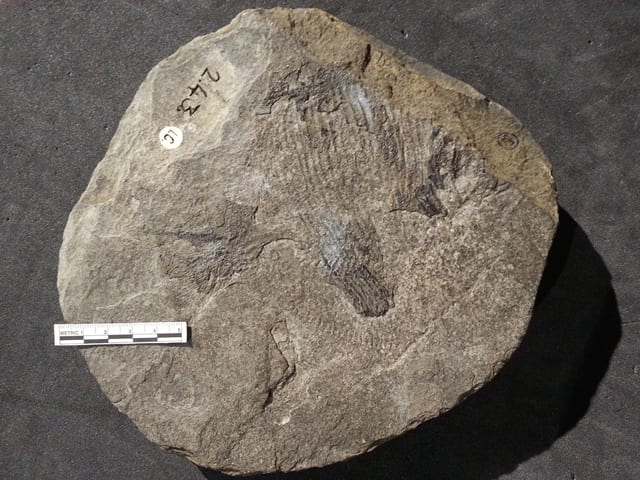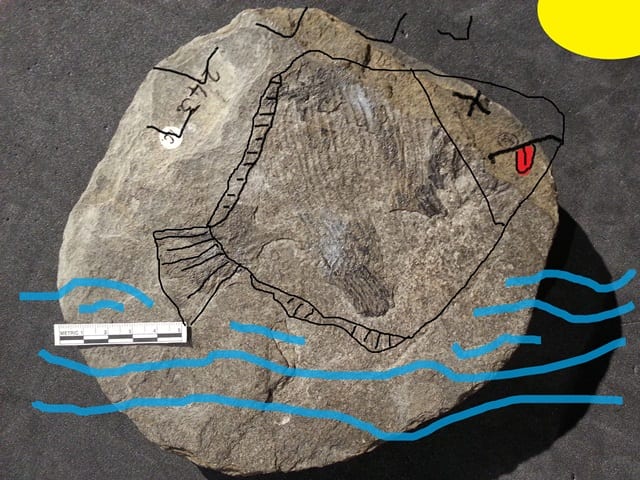Underwhelming Fossil Fish of the Month: October 2015
By Mark Carnall, on 30 October 2015
It’s that time of year, the leaves are turning brown, Christmas advent calendars are on the shelves, British people are struggling with the decision to complain about it being too hot or too cold for the time of year because its possibly both but not as clear cut as say summer or winter. But none of that matters to a fossil fish. Even if they were able to blink in life, which most couldn’t, the unblinkable, unblinking eyes of fossil fish care not for such trivial concerns as the changing of seasons. Partly because they’ve been turned to stone. Well, completely because they’ve turned to stone.
Welcome to October’s underwhelming fossil fish of the month, our monthly foray into the world of underwhelming fossil fish from the drawers and stores of the Grant Museum of Zoology. The unloved, the untreasured, the uncelebratable fossil fish. And so they should be. They’re not very interesting at the best of times. In fact, I wouldn’t carry on reading this, you’ll only be disappointed in 5, 4, 3, 2…
This month, I’ve got the opposite of a visual treat for you. A visual brussel sprout? A visual punishment? Let’s take a look, if you can call it looking because there’s not to much to look at. Regular readers may nonchalantly note that this month we’ve got a sexy black background to clash with the colours of the fossil itself taking away even further from the already low acuity.

LDUCZ-NON1227 a rather jauntily angled Platysomus. Once again I’m keen to point out that I didn’t take the photographs and it seems to be getting worse
Wasn’t worth the wait was it? According to the label, probably written the last time someone looked at this specimen sometime in the 1970s, this is a specimen of Platysomus, an extinct genus of ray-finned fish that had a good run of it from the Early Carboniferous to the Late Permian, 350 to 250 million years ago. Considering that our humble subspecies has achieved space travel, genocide, the works of Dolly Parton and pizzas with hotdogs in the crust in our mere hundreds of thousands of years, it safe to say that comparatively, Platysomus squandered its long time on Earth. Platysomus fossils have been found worldwide, in freshwater and saltwater deposits leading some* to call it the water cow of the animal world. Platysomus, like living discus fish, were very laterally compressed and round in profile like some sort of circular disc you could compete with others to throw far distances, the name of which escapes me.
Preservation Although not much to look at, most of the fish is preserved here apart from the head, which sadly normally relegates a fish fossil to perpetuity in a drawer never to see the heady heights of a museum display case. From the looks of it, there should be a much nicer counterpart to this specimen, aside from patches of scales on the flanks and tail, this fossil is an impression of the skeleton and the skin. The characteristic shape of Platysomus can be seen here, but perhaps an artistic reconstruction from a talented but unrecognised in his time can help illuminate this facet of this fossil.

Highly skilled artistic reconstruction of Platysomus breaching the surface of Carboniferous seas with errrr LARGE INSECTS flying overhead.
Or not.
Research After a quick literature search, Platysomus was one of a range of fish which were meticulously studied in a riveting period of fish palaeontology known to palaentologists as the ‘Golden Age of Looking at Fish Scales’ that dominated the driest of dinner table conversations from the mid nineteenth century until the 1920s. Throughout this period, you’d be shunned from scientific circles if you didn’t know your lacunae from lamellae from your laminae. Of course, the structure and formation of scales wasn’t of interest for it’s own merit but was seen as key to understanding how teeth, jaws and bones evolved, how our distant ancestors became more interesting than swimming meat socks and ultimately the ‘higher animals’, hotdog-stuffed crusts and all.

Scales, fins and impression of the tail of Platysomus. A very fishy tail. That’s right. I went there. I held out for a long long time though.
In Society Surprisingly, Platysomus make for great pets and companion animals, especially for busy working professionals, the lazy and the catatonic. They require very little in the way of feeding or watering and don’t require a complicated aquarium set-up. With some training they can keep even the unruliest pile of paper flat and are great at keeping relatively light doors open. They even prevent the need for those difficult discussions about death and the finite flourishing of life with children as, if looked after properly, they will outlive you and everyone you know.
Platysomus sp.
Preservation 5
Research 4
In Society 5
Underwhelmingness 6
Mark Carnall is the Collections Manager (Life Collections) at the Oxford University Museum of Natural History, and former Curator of the Grant Museum
* In the loosest sense.
4 Responses to “Underwhelming Fossil Fish of the Month: October 2015”
- 1
-
2
Richard Corney wrote on 3 December 2015:
Only just having discovered the UFFOTM, I agree with Emma-Louise – this blog is a delight. I will be excavating my way through the back issues.
-
3
Underwhelming Fossil Fish of the Month: December 2015 | UCL Museums & Collections Blog wrote on 21 January 2016:

[…] saw fossil fish leaping from the water and allegedly glistening in the sun. September was silly, October was odious and nobody noticed November. Of course, we’re one fossil fish short of a full year and it […]
-
4
Sue Jones wrote on 9 August 2016:
I adore the work of this reconstruction artist. If only there was more funding to develop this talent 🙂
 Close
Close


[…] lighter-on-quaggas Oxford University Museum of Natural History, his ever entertaining blog series Underwhelming Fossil Fish of the Month continues. Well thank goodness for that. If you’ve not had the delight before, this blog is a […]